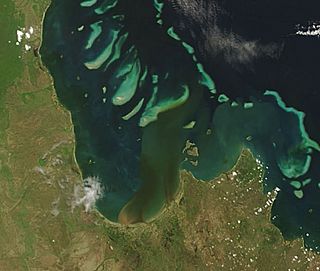Princess Charlotte Bay facts for kids
Quick facts for kids Princess Charlotte |
|
|---|---|

2007 image from NASA's Terra satellite showing plumes of sediment flowing into the bay
|
|
| Country | Australia |
| State | Queensland |
| Region | Far North Queensland |
| District | Shire of Cook |
| Physical characteristics | |
| Length | 61 km (38 mi) |
| Basin features | |
| Tributaries |
|
Princess Charlotte Bay is a large bay on the east coast of Far North Queensland in Australia. It sits at the bottom of the Cape York Peninsula, about 350 kilometers north of Cairns. This beautiful bay is part of the amazing Great Barrier Reef Marine Park. It is a very important home for the dugong, a gentle sea mammal.
The coral reefs in Princess Charlotte Bay are in excellent condition. The bay also has special areas called "green zones." These zones protect the homes of fish like barramundi and the surrounding wetlands. Commercial fishing is limited in these areas to keep the environment healthy.
Contents
History of the Bay
Princess Charlotte Bay is on the traditional lands of the Bakanambia and Jeteneru people. They have lived there for a very long time.
The bay was named in 1815 by Lieutenant Charles Jeffreys. He was part of the British Royal Navy. He named it after Princess Charlotte of Wales, who was a princess in England.
The Great Cyclone of 1899
In 1899, a very powerful storm hit Princess Charlotte Bay. This storm was called the Mahina Cyclone of 1899. It caused a lot of damage. At that time, many ships used the bay for collecting supplies. The cyclone destroyed almost all the ships that were anchored there.
This event was one of Queensland's worst disasters at sea. Many people from the pearling fleet and local Aboriginal people helping them were lost.
Geography of the Bay
Princess Charlotte Bay has interesting land features. The easternmost part of the bay is called Cape Melville. Near here, you can find Flinders Island, which is part of the Flinders Group National Park. The westernmost point of the bay is Claremont Point.
Rivers and Waterways
Several rivers flow into Princess Charlotte Bay. These include the Normanby, Bizant, North Kennedy, Marrett, and Morehead rivers. Scientists have found old marine fossils and beach ridges far inland along these rivers. This tells us that the bay has slowly been filling up with sediment over time.
During spring tides, which are very high tides, saltwater can flow several kilometers inland. The areas near the water are mostly covered by mixed mangrove forests. These trees are special because they can grow in salty water.
Wetlands and Sea Life Habitat
The wetlands next to Princess Charlotte Bay are some of the largest in Australia. The bottom of the bay has huge areas of seagrass beds. These are like underwater meadows. There are also large flat areas made of sand and mud that are covered by the tides.
Protected areas around the bay help keep it safe. These include Cliff Island National Park, Lakefield National Park, and Cape Melville National Park. If you want to visit the bay by boat, the best way is from the Bizant boat ramp. It is about 20 kilometers from the town of Bizant.
Amazing Animals of the Bay
Princess Charlotte Bay is home to many interesting animals.
Sharks and Fish
The Bizant river shark is a rare type of shark. It can live in both fresh and slightly salty water. More common sea animals found here include barramundi, blue salmon, grey mackerel, queenfish, grunter, mangrove jack, tiger prawn, and mud crab.
Dugongs
Princess Charlotte Bay and nearby Bathurst Bay have a lot of dugongs. In fact, they have some of the highest numbers of dugongs in all of Queensland! To protect these gentle creatures, a special area has been set up in Princess Charlotte Bay. This area helps limit commercial net fishing to keep the dugongs safe.

